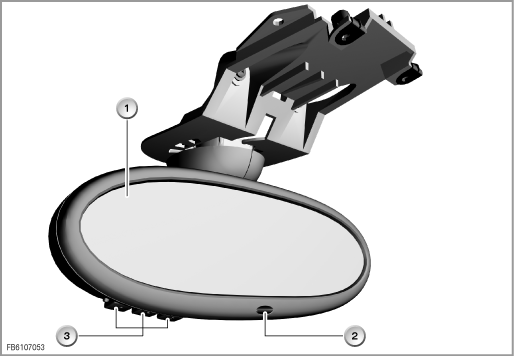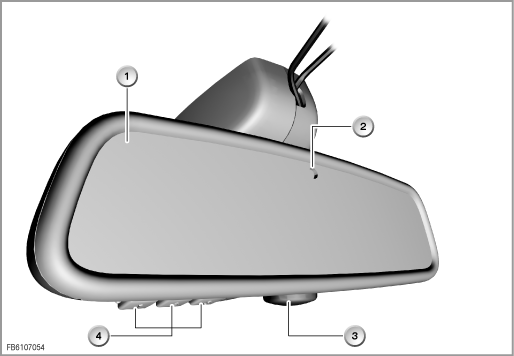
The main task of interior rearview mirror is to allow the driver to look through the vehicle from the inside to the rear. The central location in the control panel means the interior rearview mirror is also suitable to accommodate sensors and buttons.
The following components are described for the interior rearview mirror:
The central location in the control panel means the interior rearview mirror assumes a number of operating and display functions. The interior rearview mirror sends its information directly to the roof function centre (FZD).
The FZD receives information from the interior rearview mirror. The FZD is connected across the K-CAN with the footwell module (FRM) and the junction box electronics (JBE).

Graphic shows interior rearview mirror on the R56
Index |
Explanation |
Index |
Explanation |
|---|---|---|---|
1 |
Interior rearview mirror glass (electrochromic) |
2 |
Photo diode for automatic anti-glare control (electrochromic) |
3 |
Buttons for the integrated universal remote control |
|
|

Graphic shows the interior rearview mirror on the E70
Index |
Explanation |
Index |
Explanation |
|---|---|---|---|
1 |
Interior rearview mirror glass (electrochromic) |
2 |
Photo diode for automatic anti-glare control (electrochromic) |
3 |
LED for the anti-theft alarm system (DWA) |
4 |
Buttons for the integrated universal remote control |
Depending on the equipment specification, various system functions are available for the interior rearview mirror. The following system functions are described:
The electrochromic interior rearview mirror automatically dims the mirror glass if a source of light from the rear is detected. The electrochromic interior rearview mirror has two sensors that measure light incidence from the front and the rear. When the light source from the rear is strength, a voltage signal is output. The strength of the voltage signal depends on the light difference between the front and rear. The greater the voltage signal, the more the mirror glass is dimmed. The electrochromic interior rearview mirror controls the electrochromic exterior mirrors via the roof function centre (FZD) an.
The integrated universal remote control replaces up to three different hand transmitters. The integrated universal remote control can learn various radio-remote-controlled facilities, e.g. garage doors and garden gates or lighting systems. The integrated universal remote control detects and learns the sent signal from each original hand transmitter.
Functional description, see BMW Service Technology:
TIS -> Document -> SI Technology -> SBT 51_01_05_122
No liability can be accepted for printing or other errors. Subject to changes of a technical nature